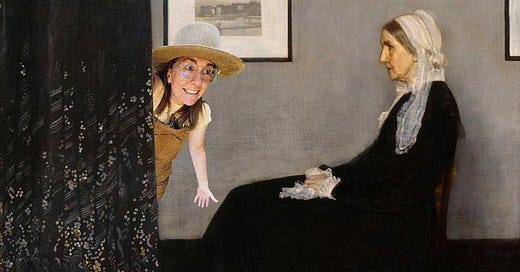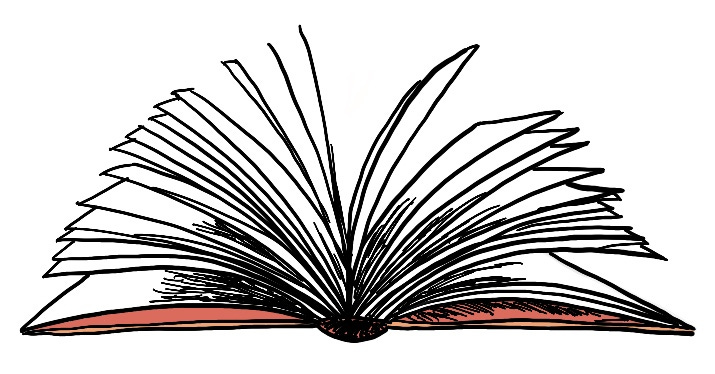Don’t like reading? Allow me to read it to you 👈
Smudge on the pane. A blur at the edge of perception. We see ourselves as nothing more than the stand ins, the light-meter ride-alongs, the frame fillers—a smear on a frosted window, forgotten in the shards.
It was never supposed to be Whistler’s Mother.
We don’t audition for this role, it is bestowed upon us by a malicious casting agent just doing their job. Blurry Friend #1. Out of Focus Crowd Filler #3. Never to be the center of attention, we bleed on out into the dense spectrum and crunch our pixels like dutiful extras.
Not photogenic enough, our presence is censored by the scenery.
Always on the blend, we stir turpentine into our oil and mash into the canvas weave, being careful to avoid the lumens of the limelight lest we steal the glint in a stranger’s eye. We stretch and arch and reach for the very corners and edges, not quite out of frame, but definitely not in it, either.
It was never supposed to be Whistler’s Mother.
We are the invisible ones. This is not our gallery, these are not our patrons.
Background actors with no scripts, that’s all we are. No union, no busting. Just the standing this way and that. Or sitting. Never the focus, always the blur. Always the blackness, never the star born to streak across a canvas sky. Unobtrusive. Space filler. Time killer.
It was never supposed to be Whistler’s Mother.
Until it was.
One can only imagine the conversation. James McNeil Whistler, West Point washout, the artistic son, mother’s bohemian boy. Anna, his mum, a champion of his work. In his corner but also, you know, in the metaphorical corner of life. She was—as all mums are—just mum. Reliable. There. Orange slices at the ready.
“Mom, Mamma, Mommy, Matron,” says James, (probably). “This absolute flake of a girl hasn’t shown for her sitting today. I’ve ALWAYS wanted to paint you as I love you so even though you don’t approve of my ‘flamboyant bohemian lifestyle’ which I only know because I read it on Wikipedia!”
Anna. Sixty-seven years old:
“[Sighs]” (probably). “If you think I’m gonna stand for this, you are sorely mistaken, Jimbo.”
She sits.
Is that what it takes to bring us to the center of the frame? A cancelation. The moment of our revelation held in the blink of a no show. A too busy. A not today.
It was never supposed to be Whistler’s Mother.
The initial smudge of her as he works the outline, the blur of her life beginning as a light gesture on canvas, firming up as time in the studio progresses and James does his art-schtick.
She sits there patiently—a mother claiming her space in his story.
Look at her! Anna, the champion of us all. All the unseen’s, the off-to-the-sides, the depth-of-field victims at the edge of thought. Getting—as the kids say—‘her flowers’ and in the process giving hope to us all that one day we too shall be the subject and not scene stuffers.
Arrangement in Grey and Black
This is what Whistler called the painting when he was done, forgetting for a moment that his mother was actually a person and not just “mother.”
He called it that—or so he said—to emphasize its aesthetic qualities rather than its subject matter. Its subject matter being his mother. A sleight? Perhaps. But we can’t ding Whistler for that. To point at him would be to point at ourselves. To highlight a quirk of human nature. The Blur Paradox.
The outline of those we love most at close volume is often filled with the most static.
The sharp edges of another person’s existence are a mystery unless we turn their dial to clear. Who thinks of their parents as having lives before us? Of being young and in love? Of doing stupid things while drunk? The true nature of their lives before we came along is blurry and out of focus until we sit and paint. Until we place them at the center of the frame.
But wait. Flip the script. Pull the focus. Turn the camera to you.
Forget how others see you for a moment—how do you see yourself?
Is blurry friend a role you have assigned yourself? Always off to the side, never the center of the frame. Are you a victim of your own depth of field f-stop obscurity?
Sure, there is value in the smudge. In the smudge, you have the freedom to be the quiet observer, collecting material for your art. It is a superpower. If you are a writer, an artist, a creative soul of any kind, in the smudge you are free to mine the complicated frames of the world, seeking materials and cements and dirts and slurries to make your pottery, your paint, your world goops, words, and more.
Relentless. Ruthless. They suspect nothing. All your pixels, blending into the background as you watch the center stage of it, smiling, even though you are not listed in the playbill. Leaning. Sitting. Holding a glass that is never filled in this wide-apertured world.
But tell me, oh fuzzy one, in the blur have you lost yourself? Are you really THAT out of focus? Or is it just how you see yourself?
Thinking ourselves smudged and invisible, we cannot comprehend that we may be seen with crystalline clarity by those observing us. It is inconceivable that we may read clear and strong in the minds of others and be the center of someone else’s life. Through the eyes of our sons and daughters, our parents, our friends and lovers and strangers on the street, we are seen. We are perceived. We are heard.
In the soundtrack of the play, we may not be the melody, but keen ears will find us in the grace notes.
Whistler, upon finishing the portrait of his mother, is said to have stepped back and said:
“Oh Mother. It is mastered. It is beautiful.”
In that moment, Anna became more than just a placeholder or a stand-in—she became a scene stealer. Finally seen in the scene and on the scene, a mother for all-times.
Arrangement in Grey and Black
Who knows what Whistler was thinking when he called his portrait that, but the world did not buy it. It did not stand. They turned his clarity dial for him, twisting until the shape of Anna became clear and strong, a signal that has broadcast in stereo, into the corners and arches and storage rooms of galleries, for over 150 years.
“Ladies and gentlemen, here before us is an exceptional oil painting you will recognize immediately, a portrait beloved by all and painted by the American-born artist, James McNeil Whistler in 1871.”
It was always going to be “Whistler’s Mother.”
Yours in tiny thought,
Janeen
Go behind the scenes of this post👇
Behind the Streams, Ep. 42: "Whistler's Mum"
Watch now (12 mins) | Did you know that "Whistler's Mother", the painting, is not actually called that? Or that Whistler's mum, Anna, was not the original choice for the portrait?
This week’s amends…
“I want to be thoroughly used up when I die, for the harder I work the more I live. I rejoice in life for its own sake. Life is no "brief candle" for me. It is a sort of splendid torch which I have got hold of for the moment, and I want to make it burn as brightly as possible before handing it on to future generations.”- George Bernard Shaw
On Rotation: “Mean Girls Give Pleasure” by Daniel Johnston
This is a visual tribute to Brian Eno’s music by artist Thomas Blanchard. When I started watching, I assumed it was digital or AI or something. But blessed be the artists, for the visual compositions are made out of paint, oil, and soap liquid.
Via Kottke
Swinging toilets. Strangely mesmerizing.
Via Boing Boing










